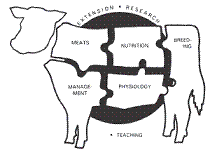Animal Science, Department of

Nebraska Beef Cattle Reports
Date of this Version
2020
Citation
The Board Regents of the University of Nebraska. All rights reserved.
Abstract
Data were compiled on feed usage to model the amount of water needed to produce beef in typical Nebraska production systems. Production systems where cows were wintered on corn residue utilized 18% less water than systems utilizing native range as a wintering source, because of water allocations. Therefore, the water footprint (gallons of water required to produce one pound of boneless meat) was decreased by 18%. In addition, increasing the dietary inclusion of distillers grains from 0% to 40% decreased the water footprint in the finishing phase by 29%, again based on water allocation. Utilizing corn residue and distillers grains in Nebraska beef cattle systems decreases the overall water footprint of production. Additionally, the water footprint of the systems analyzed was 80% green water as rain, minimizing the environmental impact of beef production on freshwater use and ecological water balance.
Included in
Large or Food Animal and Equine Medicine Commons, Meat Science Commons, Veterinary Preventive Medicine, Epidemiology, and Public Health Commons


Comments
2020 Nebraska Beef Cattle Report